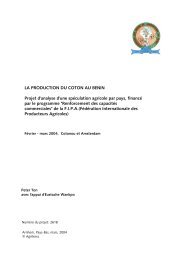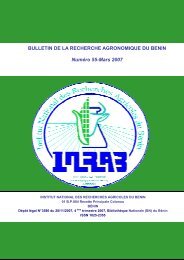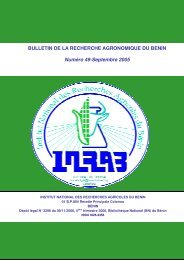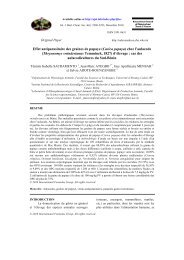Lien externe ou de téléchargement - Slire
Lien externe ou de téléchargement - Slire
Lien externe ou de téléchargement - Slire
- No tags were found...
You also want an ePaper? Increase the reach of your titles
YUMPU automatically turns print PDFs into web optimized ePapers that Google loves.
Bulletin <strong>de</strong> la Recherche Agronomique du Bénin Numéro 69 – Juin 2011Substitution partielle du lait en p<strong>ou</strong>dre par le lait <strong>de</strong> soja p<strong>ou</strong>r la production duya<strong>ou</strong>rtI. Bokossa Ya<strong>ou</strong> 12 , C.K.C. Tchekessi 12 , P. Doss<strong>ou</strong>-Yovo 13 , M. Eg<strong>ou</strong>nlety 14 et R.M.Dossa 14RésuméLe ya<strong>ou</strong>rt, un lait fermenté à l’ai<strong>de</strong> <strong>de</strong>s bactéries spécifiques (Lactobacillus bulgaricus etStreptococcus thermophilus) était produit à 40 °C pendant 4 h à partir du lai t en p<strong>ou</strong>dre reconstituécontenant 15 <strong>ou</strong> 20% du lait <strong>de</strong> soja. Le lait <strong>de</strong> soja était préparé suivant le processus ci-après : lesgraines <strong>de</strong> soja ont été trempées dans <strong>de</strong> l’eau <strong>de</strong> robinet (P/V= 1/5) pendant 18 h, blanchies dans <strong>de</strong>l’eau chau<strong>de</strong> à 100 °C pendant 20 secon<strong>de</strong>s puis m<strong>ou</strong>l ues au m<strong>ou</strong>lin à disque avant d’êtrehomogénéisées et lessivées dans <strong>de</strong> l’eau b<strong>ou</strong>illante (P/V=1/7) p<strong>ou</strong>r y extraire le lait <strong>de</strong> soja etpréparer les ya<strong>ou</strong>rts correspondants. Le ren<strong>de</strong>ment en lait était <strong>de</strong> 71,1% et celui en ya<strong>ou</strong>rt <strong>de</strong> 110%.Les résultats <strong>de</strong>s analyses physico-chimiques <strong>de</strong>s ya<strong>ou</strong>rts à 15 et à 20% au lait <strong>de</strong> soja révélaient queleur acidité et leur pH étaient similaires à ceux du ya<strong>ou</strong>rt témoin à 100% au lait en p<strong>ou</strong>dre reconstitué.Les teneurs en protéines et en azote <strong>de</strong>s ya<strong>ou</strong>rts à 15 et à 20% au lait <strong>de</strong> soja étaient plus élevés,contre celles <strong>de</strong>s cendres plus faibles. Des analyses sensorielles montraient que les ya<strong>ou</strong>rts au lait <strong>de</strong>soja ont reçu les mêmes appréciations que le ya<strong>ou</strong>rt témoin en ce qui concerne l’arôme, le goût et latexture. Cependant, les ya<strong>ou</strong>rts au lait <strong>de</strong> soja étaient plus appréciés en c<strong>ou</strong>leur et globalementacceptés par les panélistes <strong>de</strong> la dégustation. Ainsi, le ya<strong>ou</strong>rt <strong>de</strong> bonne qualité peut être produit parl’incorporation jusqu’à 20% du lait <strong>de</strong> soja.Mots clés : soja, lait <strong>de</strong> soja, lait en p<strong>ou</strong>dre, ferments, ya<strong>ou</strong>rtPartial substitution of pow<strong>de</strong>red milk with soymilk in the production of yoghurtAbstractYoghurt, a dairy food fermented with specific bacteria of Lactobacillus bulgaricus and Streptococcusthermophilus was processed at 40 °C for 4 h<strong>ou</strong>rs from reconstitu ted pow<strong>de</strong>red milk containing up to15 or 20% soymilk. Yoghurts were obtained from soymilk prepared as followed : Beans were soakedin tap water (P/V= 1/5) for 18 h<strong>ou</strong>rs, preheated by soaking for 20 seconds in hot water (100 °C),gr<strong>ou</strong>nd and homogenized in boiling water (P/V= 1/7). The resulted slurry was filtered with 0.18 mmsieve to obtain soymilk and to prepare corresponding yoghurts. Physicochemical characteristics, yield,sensory evaluation and statistical analysis were performed. Obtained results showed that soymilk andyoghurt percentage yields were 71.1 and 110 respectively. Physicochemical analysis showed thatyoghurts containing soymilk were comparable with reconstituted pow<strong>de</strong>red milk yoghurt in titratableacidity, in pH and richer in protein, ash and nitrogen than reconstituted pow<strong>de</strong>red milk yoghurt.Sensory evaluation showed no significant difference between yoghurts containing soymilk andreconstituted pow<strong>de</strong>red milk yoghurt in aroma, in texture and in taste, but the yoghurt containing thesoymilk had the best col<strong>ou</strong>r and was overall accepted by panellists. Thus, good quality yoghurt can beproduced with 20% soymilk as substitutes for reconstituted pow<strong>de</strong>red milk.Key words: soy beans, pow<strong>de</strong>red milk, soymilk, ferment, yoghurt12 Dr. Ir. I. Bokossa Ya<strong>ou</strong>, Laboratoire <strong>de</strong> Microbiologie et <strong>de</strong>s Technologies Alimentaires, Département <strong>de</strong> Biologie Végétale<strong>de</strong> la Faculté <strong>de</strong>s Sciences et Techniques (FAST), Université d’Abomey-Calavi (UAC), 04 BP 1107 Coton<strong>ou</strong>,Tél. :(+229)95962942, E-mail : innobokos@yahoo.fr, République du Bénin ;12 C.K.C. Tchekessi, Laboratoire <strong>de</strong> Microbiologie et <strong>de</strong>s Technologies Alimentaires, Département <strong>de</strong> Biologie Végétale <strong>de</strong> laFaculté <strong>de</strong>s Sciences et Techniques (FAST), Université d’Abomey-Calavi (UAC), 04 BP 1107 Coton<strong>ou</strong>,Tél. :(+229)97810040, E-mail : tchecokice@yahoo.fr, République du Bénin ;13 Dr. P. Doss<strong>ou</strong>-Yovo, Laboratoire <strong>de</strong> Recherche en Traitement et Conservation <strong>de</strong>s Produits Halieutiques du Département<strong>de</strong> Chimie, FAST/UAC, BP 1270 Abomey-Calavi, Tél. :(+229)93797239, E-mail : pidam57@uacyahoo.fr, République duBénin ;14 Prof. Dr. Ir. M. Eg<strong>ou</strong>nlety, Laboratoire <strong>de</strong> Microbiologie et <strong>de</strong> Biotechnologie Alimentaire, Département <strong>de</strong> Nutrition,Sciences et Technologies Alimentaires, Faculté <strong>de</strong>s Sciences Agronomiques (FSA/UAC), 01 BP 526 Abomey-Calavi,Tél. :(+229)98313789, E-mail : em<strong>ou</strong>tair<strong>ou</strong>@yahoo.fr, République du Bénin ;14 Prof. Dr. Ir. A.R.M. Dossa, Laboratoire <strong>de</strong> Microbiologie et <strong>de</strong> Biotechnologie Alimentaire, Département <strong>de</strong> Nutrition,Sciences et Technologies Alimentaires, Faculté <strong>de</strong>s Sciences Agronomiques (FSA/UAC), 01 BP 526 Abomey-Calavi, E-mail : ansromarc@yahoo.fr, République du Bénin.48
















